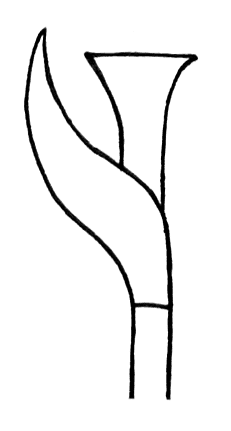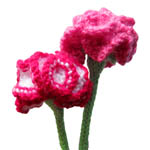Daffodils (R3)

This daffodil pattern is knitted in four parts – trumpet, petals, spathe (brown bit), and stem. Never make the petals a darker shade than the trumpet or your daffodil will look very strange.
A printable version of this pattern is available.
You will need:
- yarn leftovers in yellows, beige and green (double knit)
- covered wire
- gummed tape
- 4 x double ended knitting needles (2.75mm)
- tapestry needle
- scissors
- wire cutters
Pattern:
(A list of abbreviations is available.)
Petals
Cast on 3 stitches in yellow.
I-cord 6 rows and then separate stitches out onto three needles and continue working in the round.
- Round 1: kfb x 3 (6)
- Round 2: [kfb, k1] x 3 (9)
- Round 3: kfb x 9 (18)
- Round 4: kfb x 18 (36)
Switch to working in the flat for the first of the petals as follows:
PETAL
- Row 1: k1, kfb x 3, k2 (9)
- Row 2: [p1, k1] x 4, p1
- Row 3: kfb x 8, k1 (17)
- Row 4: [p1, k1] x 8, p1
- Row 5: [k1, p1] x 8, k1
- Row 6: [p1, k1] x 8, p1
- Row 7: [k1, p1] x 8, k1
- Row 8: [p1, k1] x 8, p1
- Row 9: k1, k2tog x 2, [p1, k1] x 4, k2tog x 2
- Row 10: [p1, k1] x 6, p1 (13)
- Row 11: k1, k2tog x 2, [p1, k1] x 2, k2tog x 2
- Row 12: [p1, k1] x 4, p1 (9)
- Row 13: k1, k2tog x 4 (5)
- Row 14: p1, p2tog x 2 (3)
Thread yarn through remaining sts and pull tight.
Work the pattern for PETAL six times, so that no stitches remain. Rejoin the yarn to the live stitches after each petal is completed.
Trumpet
Cast on 9sts in orange and join into the round.
- Round 1: k –
- Round 2: kfb x 9
- Rounds 3 to 12: [k1, p1] x 9
- Round 13: p –
Repeat the following bullet points until no stitches remain.
- cast on 1st
- cast off 2sts
- If your cast off method leaves a stitch on the RH-needle, transfer it back to the LH-needle.
Turn the finished trumpet inside out.
Stem
Cast on 5sts in green. I-cord for around 20cm to form the stem, then separate stitches onto 3 needles and continue in the round.
- Round 1: kfb x 5
- Rounds 2 & 3: k –
Cast off.
Spathe
Cast on 6sts in beige and join into the round.
- Rounds 1 to 3: k –
- Round 4: k5, kfb
- Round 5: k –
- Round 6: k6, kfb
- Round 7: k –
From this point on the spathe will be worked in the flat, but you may want to wait a few rounds before transferring all stitches to a single needle.
- Row 8: k – (8)
- Row 9: pfb, p7 (9)
- Row 10: kfb, k8 (10)
- Row 11: pfb, p9 (11)
- Row 12: kfb, k10 (12)
- Row 13: p –
- Row 14: k –
- Row 15: p2tog, p10 (11)
- Row 16: k2tog, k9 (10)
- Row 17: p –
- Row 18: k –
- Row 19: p2tog, p8 (9)
- Row 20: k2tog, k7 (8)
- Row 21: p2tog, p6 (7)
- Row 22: k2tog, k5 (6)
- Row 23: p2tog, p4 (5)
- Row 24: k2tog, k3 (4)
- Row 25: p2tog, p2 (3)
- Row 26: k2tog, k1 (2)
Thread yarn through remaining sts and pull tight.
Making Up:
Arrange the petals so they are alternately completely on top or completely underneath their neighbours. Use the loose ends of yarn to sew them into position.

Feed the i-cord stamen at the centre of the petals through the small hole in the base of the trumpet. Sew the base of the trumpet into position.
Cut a length of covered wire such that it will just fit inside the i-cord stem. Cover both ends in gummed tape and insert it into the knitted tube. Sew the cast off end of the tube to the centre of the reverse side of the petals.
Insert the stem into the knitted spathe so that the flat part of the spathe points towards the flower. Sew it into position so that there is only around a centimetre of green stem showing between the spathe and the petals.

Once all remaining loose ends have been woven in bend the stem at right angles at the bottom of the spathe.
Notes:
Needle/Yarn Size
As with most ODDknit patterns the yarn and needle sizes in the "you will need" section are just a guide. Feel free to improvise with whatever needles and yarn you have lying around - that's half the fun!
<<< See more Flowers
© 2015 All desgins and images are copyright of ODDknit. If you enjoy the content of this website, please consider buying me a coffee at the link below.





